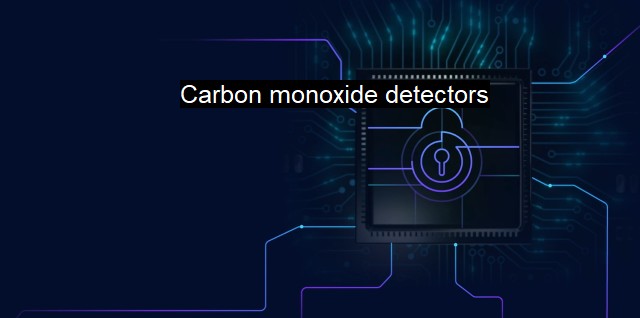What are Carbon monoxide detectors?
The Importance of Carbon Monoxide Detectors in Cybersecurity: Understanding the Connection and Mitigating Potential Dangers
The term "Carbon Monoxide Detector" assumes an important role, similar to the device designed to alert those in a dwelling to the presence of dangerous carbon monoxide levels. Just as these physical detectors are crucial for safeguarding individuals from lurking dangers they cannot perceive, the virtual world requires a similar form of a monitor to track threats that are not detectable to the unaided human eye. In this context, a "Carbon Monoxide Detector" can be understood as an advanced system that guards against potential threats in the digital world.Contrary to viruses that explicitly corrupt your data or crash your systems, there exist malicious activities that invisibly threaten your information security universe. These non-intrusive attacks, called silent-attacks, are like the carbon monoxide of digital threats – invisible yet deadly, non-tangible yet vastly dangerous. With the pursuit to spy, steal, disrupt or deface, these threats can infect systems, siphon off critical information, manipulate sensitive data, and crash cyber-infrastructure without making discernible noise. Hence comes the absolute necessity of having a "carbon monoxide detector" in cybersecurity.
This "Carbon Monoxide Detector" functions on the principles of anomaly detection and deep learning. It uses AI, machine learning, and large-scale data analytics to facilitate a path for anomaly detection inspecting and contrasting behaviors and activities within the network to recognize any deviation that possibly indicates a concealed attack. The monitoring system operates ethically and examines the intercommunication between files, applications, servers, and networks to spot suspicious behavioral changes, irregular data movements, or unusual network traffic patterns.
In the domain of cybersecurity, the "Carbon Monoxide Detector" is also defined by the efficacy of the antivirus program. An effective antivirus software behaves like a carbon monoxide detector by persistently alerting against prospective threats. By screening every file that enters the system and comparing it against an extensive database of known threats, it establishes a layer of active premise-security.
Modern antivirus programs are integrated with heuristic analysis capabilities that allow for the detection of new, unseen viruses by scrutinizing the skeleton of the program, and evaluating its potential threat considering various factors before deeming it harmful or not. these antiviruses inherently become the "Carbon Monoxide Detector" by providing a real-time scanning feature that runs in the background without disrupting the user's access to the device's functionalities.
Equally important is the role of the firewall as a "Carbon Monoxide Detector." It envisages maintaining the sanctity of information by blocking unauthorized access to a computer system while permitting unrestricted outbound communication. The firewall carefully inspects all communication and data packets moving in and out of the network, verifying their legitimacy by juxtaposing them to predefined security protocols and rules. A breach would set off the alarm, much like a real carbon monoxide detector would in an unsafe environment.
In the large cosmic digital network of insecure open systems, open ports, unchecked emails, unknown file downloads and accessibility to malicious web-phishing entities are analogous to leisurely unlocked doors and windows in the physical world that invite threats. To scan, scrutinize, and to safeguard against these invisible vulnerabilities, the "Carbon Monoxide Detector" is paramount. This symbiotic coordination of the "Carbon Monoxide Detector", antivirus systems, and cybersecurity measures infuses a sense of security into this otherwise ‘not-very-innocuous’ digital world.
Just as carbon monoxide detectors alert us to unseen, odorless, and fatal gas in our homes, in the digital arena, our "carbon monoxide detector" warns us of the stealthy threats posed by cyber criminals. Cybersecurity threats are silent, complex, and persistent, just like carbon monoxide. Yet they can be detected and stopped in their tracks with well-implemented alert systems that constantly watch for malicious anomalies, much like stellar antivirus systems and the appropriate cybersecurity measures.

Carbon monoxide detectors FAQs
How do carbon monoxide detectors relate to cybersecurity?
Carbon monoxide detectors themselves do not directly relate to cybersecurity. However, some smart carbon monoxide detectors may connect to a Wi-Fi network, which could potentially pose a cybersecurity risk if not properly secured. It is important to ensure that any internet-connected device, including a smart carbon monoxide detector, is equipped with appropriate security measures.Do I need to replace my carbon monoxide detector every year?
It is recommended to replace carbon monoxide detectors every 5-7 years. However, it is important to regularly test your carbon monoxide detector and replace the battery as necessary. Some detectors may also have an expiration date listed on the device.Can antivirus software protect my carbon monoxide detector?
Antivirus software is not applicable to carbon monoxide detectors. Carbon monoxide detectors are physical devices that detect the presence of carbon monoxide gas and sound an alarm to alert occupants. Antivirus software is designed to protect electronic devices from malware and cyber threats.Can carbon monoxide detectors detect other types of gas leaks?
Carbon monoxide detectors are specifically designed to detect the presence of carbon monoxide gas. They may not detect other types of gas leaks, such as natural gas or propane. It is important to have separate detectors for different types of gas and to regularly check for gas leaks in your home.| | A | | | B | | | C | | | D | | | E | | | F | | | G | | | H | | | I | | | J | | | K | | | L | | | M | |
| | N | | | O | | | P | | | Q | | | R | | | S | | | T | | | U | | | V | | | W | | | X | | | Y | | | Z | |
| | 1 | | | 2 | | | 3 | | | 4 | | | 7 | | | 8 | | |||||||